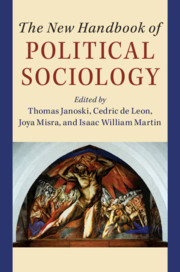Book contents
- The New Handbook of Political Sociology
- The New Handbook of Political Sociology
- Copyright page
- Dedication
- Contents
- Tables
- Figures
- Contributors
- Acknowledgments
- Introduction
- I Theories of Political Sociology
- II Media Explosion, Knowledge as Power, and Demographic Reversals
- III The State and Its Political Organizations
- IV Civil Society: The Roots and Processes of Political Action
- V Established and New State Policies and Innovations
- VI Globalization and New and Bigger Sources of Power and Resistance
- 36 Global Political Sociology and World-Systems
- 37 Liberalizing Trade and Finance
- 38 The Racial State in the Age of Racial Formation Theory and Beyond
- 39 Democracy and Autocracy in the Age of Populism
- 40 Transnational Social Movements
- Index
- References
38 - The Racial State in the Age of Racial Formation Theory and Beyond
from VI - Globalization and New and Bigger Sources of Power and Resistance
Published online by Cambridge University Press: 22 February 2020
- The New Handbook of Political Sociology
- The New Handbook of Political Sociology
- Copyright page
- Dedication
- Contents
- Tables
- Figures
- Contributors
- Acknowledgments
- Introduction
- I Theories of Political Sociology
- II Media Explosion, Knowledge as Power, and Demographic Reversals
- III The State and Its Political Organizations
- IV Civil Society: The Roots and Processes of Political Action
- V Established and New State Policies and Innovations
- VI Globalization and New and Bigger Sources of Power and Resistance
- 36 Global Political Sociology and World-Systems
- 37 Liberalizing Trade and Finance
- 38 The Racial State in the Age of Racial Formation Theory and Beyond
- 39 Democracy and Autocracy in the Age of Populism
- 40 Transnational Social Movements
- Index
- References
Summary
Since its first publication in 1986, Racial Formation in the United States by Michael Omi and Howard Winant has been arguably the most important theoretical text on race in sociology. In some real sense, the three decades between the first and the third editions were the age of racial formation theory. Over 12,000 citations ago, however, the book’s initial reception in the discipline was less than auspicious. Reviews in sociology journals were few and mixed (Driver 1988; Gordon 1989; Nagel 1988), but more than anything, disinterest prevailed.
- Type
- Chapter
- Information
- The New Handbook of Political Sociology , pp. 1003 - 1026Publisher: Cambridge University PressPrint publication year: 2020



